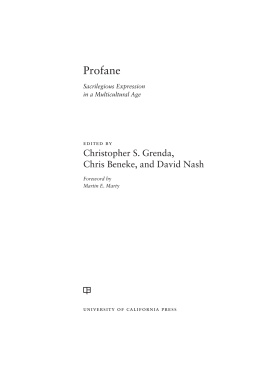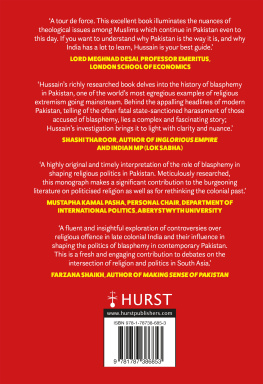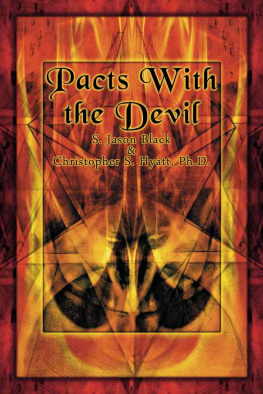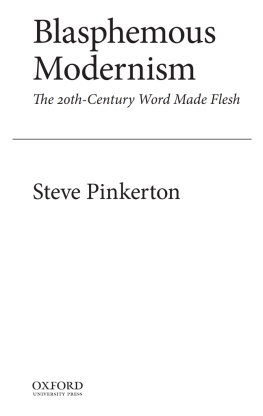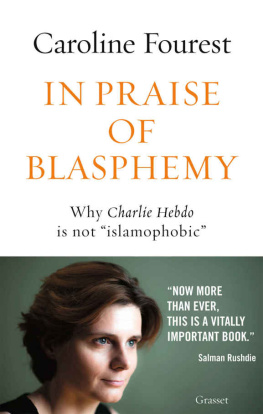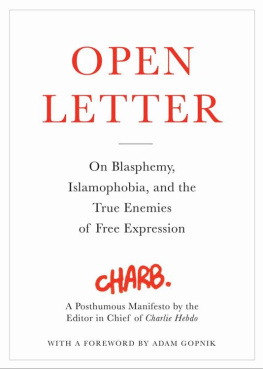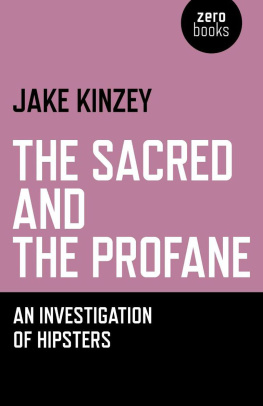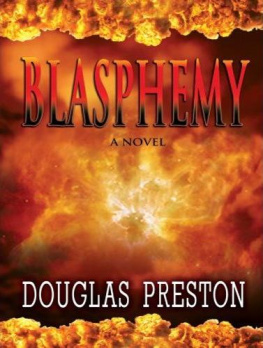3.1.
3.2.
3.3.
3.4.
3.5.
3.6.
3.7.
3.8.
3.9.
3.10.
7.1.
7.2.
Foreword
MARTIN E. MARTY
Blasphemers, profaners, and producers of the sacrilegious are to be found in most cultures, especially those that hold religion in high regard. Readers of this book will soon learn that attacks on and undercuttings of religions acquire many names, usually in terms of what they oppose, and what they oppose changes so often that the attackers are usually very busy people.
Because I am a historian of religions, I had to ask why the editors and authors gave me the privilege of helping to introduce their volume. We scholars of religion dont usually employ inflammatory words such as blasphemy or profaneness, instead preferring abstract terms to deal with such phenomena. Secularization had long been one such term, perhaps because it sounds neutral. Yet while it is still at home in some scholarly discourse today, it almost always gives harbor and encouragement not merely to nonreligion but also to whatever might subvert religion.
The authors in this collection venture far from the conventional boundaries of the study of religions. They do so in pursuing the logic of their respective disciplines as well as in crossing disciplinary boundaries as their subjects and contexts demand. When I began work in this field three score years ago, one of its key areas was described as a dialectic of belief and unbelief. Ever since I began to publish, unbelief has been a specialty of mine. It showed up in a doctoral dissertation, later spruced up and published as The Infidel: Freethought and American Religion (Cleveland: Meridian Books, 1961) and tidied up still further as The Varieties of Unbelief (New York: Holt, Rinehart and Winston, 1964). Official Catholicism established a Vatican Secretariatus Pro Non Credendibus, which held conferences in which I participated in Rome and Baden bei Wien in 1976. Out of the Rome conference came a book, The Culture of Unbelief (Berkeley: University of California Press, 1971), and later the two-volume Encyclopedia of Unbelief (Buffalo: Prometheus Books, 1985). Terms such as blasphemy and profaneness did not appear in any of these, though they were clearly vital to the culture of unbelief.
Significantly, in the postWorld War II era, Western scholars played up the conflict between belief and unbelief, thus accenting the cognitive and intellectual dimensions of religious expression. What stunned me as I read Profane was how time bound and culture bound that imagined conflict was. Contributors to the present collection do justice to the doctrines and the intellectual substance of religious belief over against unbelief. But recent generations of scholars, including authors in this book, are not content to consider the propositional or dogmatic sides of belief and its antagonists. They want to get closer to their religious and antireligious subjects and tease out the meaning and significance of blasphemy and profaneness.
None of their terms are novel. Blasphemy has always erupted and interrupted where religious cultures are vibrant and their importance taken for granted. In previous eras and other cultures, it was easier than nowas evidenced in the chapters aheadto define, censor, legislate, or police the blasphemer. But it is the fact of the protean, viscous, and sometimes elusive character of the blaspheming violators that draws attention and demands inquiry now.
Similarly, the profane has been observed, isolated, and inquired about as long as there has been a well-defined understanding of the sacred, however described. The profane ( pro-fanum, across the threshold of the sanctuary) is simpler to discuss when it manifests itself in a homogenous religious culture, where the sanctuaries are readily identifiable. In this book, however, the authors have to deal with multireligious expressions that may have little to do with state-sanctioned sanctuaries. They find such expressions newly invigorated in an age of images. For an introduction to this perspective, explore the ubiquitous digital phenomena that, as David Lawtons chapter 3 explains, challenge traditional textual expressions. How is the blasphemer censored when he or she is not easily taken captive as a specimen for study? Every day, social media generates countless opportunities for public dissent or affirmationsuch as Facebooks ubiquitous Like button and Twitters Retweet optionwhich can subvert religious authority in an instant.
As for sacrilege, the term survives, but it demands different approaches than it might have when the sacred was more easily isolated and defined. Many of the following pages revisit historic inventors and purveyors of sacrilegious phenomena, but the volumes contributors are busiest when they deal with contemporary expressions. Sacrilege, as Christopher S. Grenda shows, thrives on satire (see chapter 1). Satire abounds in popular and high culture alike. As this foreword is being written, wildly popular comedians host late-night news shows that regularly and derisively feature religious topics. So far as I can tell, religious viewers make up no small part of their audiences. What does it mean when such iconic figures display ambivalence or casual irreverence toward religion? Comic portrayals may have corrosive effects on religious communities, but these communities are too fluid, kinetic, and vulnerable to provide a stable object of sacrilege. Yet something important, perhaps even something sacred, is being subverted.

